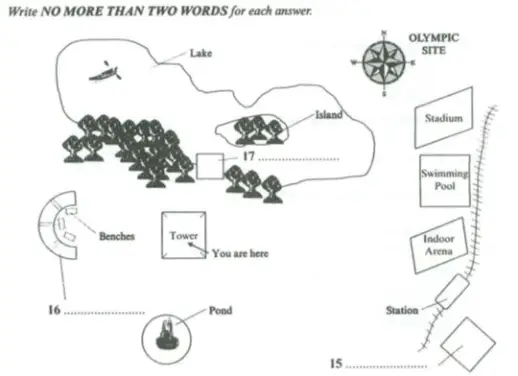How To Do IELTS Listening Labeling A Plan Or Map
Remember, the IELTS listening test has 4 parts each with 10 questions and lasts for 30 minutes in total. After that you will then have 10 minutes to move your answers to the answer sheet provided.
- Part 1 is a general conversation between 2 people.
- Part 2 is a monologue with just one person talking about a general topic.
- Part 3 is an everyday conversation between 2-3 people.
- Part 4 is one speaker giving an academic lecture.
Labeling a plan or a map in the IELTS listening test are often more difficult than they should be. This is how they might appear:

Below is my step by step guide on how to do IELTS plan and map labeling questions:
1.Read all of the question instructions carefully.
2. Take a moment to understand the layout of the map and the where the main features presented are located in relation to each other.
3. Consider where the recording is likely to begin from and the features surrounding that point.
4. Predict the word type of the answer. Is it room names, areas, numbers and so on.
5. Listen carefully to understand the situation being talked about.
6. Picture what is being described in your mind.
7. Use the ‘signposting language’ to follow the talk accurately.
8. Use the question paper to jot down your answers and transfer them over at the end.
9. Guess if you need to and then move on.
Tips and Tricks
This question type often occurs in section 2 of the test and there will usually be one person speaking that guides you through a location such as a hotel, university campus, or village/town.
The recording provides the information that you will need to answer the questions in the same order as the questions. This means that if you think you have gotten 'lost' in the recording simply look at the next questions and you should be able to tell which question the recording has moved on to.
Be careful with spellings and make sure you check them. This is important as you will not get the mark if you do not get the spelling correct and candidates often forget this point as there is so much to focus on in this question type.
Try to imagine yourself being guided around the location. This can really help to orientate yourself and follow the directions you are being given. See yourself following the directions in the map/plan and your accuracy will often improve.
It is essential to be able to recognise and use a variety of language for directions and locations. This will be key for your accuracy in these questions types so make sure you revise these. Here is a sample of useful language you should be able to use:
Opposite / in front of / behind
South / North / East / West
Southeast / Southwest / Northeast / Northwest
Inside / outside
Just beyond / a little beyond / just past
In the middle / in the centre
Above / below
in between / in the middle of
Next to / alongside / adjoining (= next to or joined with)
To the north / to the south / to the east / to the west
At the top / at the bottom
On the left of the…/ on the right of the…
On the left hand side / on the right hand side
A Few More Ideas To Help:
Sometimes between recordings there is an opportunity for a short break. Avoid using this time to check previous answers and instead use this to read ahead and understand the upcoming multiple choice questions.
Don’t get ‘held up’ on one question if you are not sure, make your best guess and be ready for the next question.
If you hear words such as, ‘even though’, ‘but’, or ‘however’ then this can be a sign that the meaning of a sentence is going to be modified in some way which may affect your choice.
And finally, make sure you are clear on the the steps you are going to go through when answering each IELTS listening question type. Practicing the steps will give you confidence and help you remain calm on test day AND hopefully boost your score!
Free IELTS Listening Samples And Practice Tests
A full online version of the listening test from the British Council.
IELTS Writing Task 1 (Academic)
Discover how to describe all types of visual data that you may see in this part of the test.
Sshhhhh! Listen closely, here are some valuable tips, techniques and strategies for maximising your listening band score.
IELTS Writing Task 1 (General)
Discover how to write in the correct format and tone for this part of the test.
Learn 'what' to say and 'how' to say it in each part of the test to impress the examiner.





